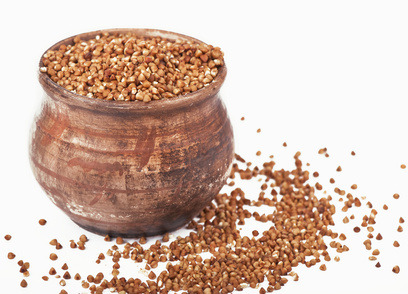Fermented foods are so off the menu for me histamine-wise that I don’t recognise them as food anymore. My last attempt, store bought coconut yoghurt (lactose free), bought me a whole lotta face-down pillow time as it worked it’s magic on my digestive tract.
Ok, enough of the dirty talk.
So what’s a histamine-challened gal to do? I ♥ my beneficial bacteria big time but am in no way willing to risk that kind of down time again. Others might not be so sensitive, it’s one of the, um, perks, of not taking any anti-histamine/allergy meds.
It’s frustrating because beneficial bacteria does help lower histamine! But this study showed that the strains with the antihistaminic action are only found in human infant bowels. Not something I’d like for lunch really.
So I examined the alternatives…a little research on my day’s menu not only turned up that buckwheat may be an anti-allergenic food for some due to its rutin bioflavonoid content, more so the leaves and the dark flour than noodles [1], that it inhibits cancer spread (read more here), but also that it’s a pre-biotic.
UPDATED POST:
Unfortunately with two confirmed cases of buckwheat anaphylaxis and a rising number in other European countries as well as the “home” of buckwheat, Japan, where it’s actually becoming a serious problem [2], it seems that chronic exposure to buckwheat may pose a risk to those pre-disposed to allergies. I have in recent years cut back my buckwheat because of its extremely high oxalic acid content. You can read all about oxalates here.
I’m leaving all the information here for you and your doctor to decide together. Read on for alternative prebiotic foods…
Click here to learn how to create your own histamine balanced diet and healing plan.

Sorry, couldn’t resist sticking in a Little Rascal’s Picture of “Buckwheat”!
This buckwheat…

shows particular increases in Lactobacillus plantarum, Bifidobacterium spp and Bifidobacterium lactis.
A prebiotic was first defined as (1) “a nondigestible food ingredient that beneficially affects the host by selectively stimulating the growth and/or activity of one or a limited number of bacteria in the colon, and thus improves host health.” Read the full study here.
They then touch on my favourite topic, moderation with supplements, when the stress that quantity is not predictive of success…
The daily dose of the prebiotic is not a determinant of the prebiotic effect… The major factor that quantitatively controls the prebiotic effect is the number of bifidobacteria per gram of feces the volunteers have before supplementation of the diet with the prebiotic begins.The “dose argument” (often used for marketing some prebiotics) is thus not supported by the scientific data; it is misleading for the consumer.”
Here’s a chart of the top prebiotic foods – according to the US Dept of Agriculture.
From Wikipedia…
Top 10 Foods Containing Prebiotics
FoodPrebiotic Fiber Content by Weight
Raw Chicory Root 64.6%
Raw Jerusalem Artichoke 31.5%
Raw Dandelion Greens24.3%
Raw Garlic17.5%
Raw Leek11.7%
Raw Onion8.6%
Cooked Onion 5%
Raw Asparagus 5%
Raw Wheat bran 5%
Whole Wheat flour, Cooked4.8%
Raw Banana1%
Source[12]
While there is no broad consensus on an ideal daily serving of prebiotics, recommendations typically range from 4 to 8 grams (0.14–0.28 oz) for general digestive health support, to 15 grams (0.53 oz) or more for those with active digestive disorders. Given an average 6 grams (0.21 oz) serving, below are the amounts of prebiotic foods required to achieve a daily serving of prebiotic fiber:
FoodAmount of food to achieve 6 g serving of prebiotics
Raw Chicory Root 9.3 g (0.33 oz)
Raw Jerusalem Artichoke19 g (0.67 oz)
Raw Dandelion Greens24.7 g (0.87 oz)
Raw Garlic34.3 g (1.21 oz)
Raw Leek51.3 g (1.81 oz)
Raw Onion69.8 g (2.46 oz)
Cooked Onion120 g (4.2 oz)
Raw Asparagus120 g (4.2 oz)
Raw Wheat Bran120 g (4.2 oz)
Whole Wheat Flour, Cooked125 g (4.4 oz)
Raw Banana600 g (1.3 lb)
Please don’t forget antihistamine, pain killing foods can still hurt us, so please always check with your doctor before adding new foods to your diet
The Anti-cookbook and all liquid Anti-Detox Book, don’t treat any conditions, but are high in the high nutrient antihistamine and anti-inflammatory ingredients that have been instrumental in helping me feed myself on a limited diet. The Anti-cookbook features a six page list of antihistamine and anti-inflammatory foods and comes in regular and Paleo.
The Low Oxalate Cookbook features antihistamine and anti-inflammatory rich recipes.
Don’t miss the Low Histamine Beauty Survival Guide for non-toxic beauty tips, the skinny on histamine releasing (mast cell degranulating) beauty ingredients, antihistamine and anti-inflammatory beauty alternatives and the top brands natural brands I’ve found.
Take a peek at my other low histamine and antihistamine cookbooks for more high nutrient recipes and sign up to my mailing list for freebies.
————- REFERENCES ————
[1] http://www.sciencedirect.com/science/article/pii/S0308814605005376
http://www.ncbi.nlm.nih.gov/pmc/articles/PMC3214221/













